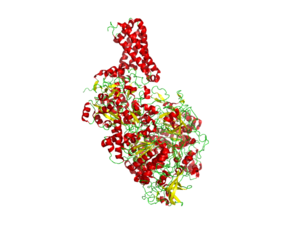
Nitrate reductase
Encyclopedia

Redox
Redox reactions describe all chemical reactions in which atoms have their oxidation state changed....
nitrate
Nitrate
The nitrate ion is a polyatomic ion with the molecular formula NO and a molecular mass of 62.0049 g/mol. It is the conjugate base of nitric acid, consisting of one central nitrogen atom surrounded by three identically-bonded oxygen atoms in a trigonal planar arrangement. The nitrate ion carries a...
(NO) to nitrite
Nitrite
The nitrite ion has the chemical formula NO2−. The anion is symmetric with equal N-O bond lengths and a O-N-O bond angle of ca. 120°. On protonation the unstable weak acid nitrous acid is produced. Nitrite can be oxidised or reduced, with product somewhat dependent on the oxidizing/reducing agent...
(NO).
- Eukaryotic nitrate reductases are part of the sulfite oxidase family of molybdoenzymes.
- Prokaryotic nitrate reductases belong to the DMSO reductase family of molybdoenzymes and have been classified into three groups, assimilatory nitrate reductases (Nas), respiratory nitrate reductase (Nar), and periplasmic nitrate reductases (Nap). The active site of these enzymes is a Mo ion that is bound to the four thiolate functions of two pterin molecules. The coordination sphere of the Mo is completed by one amino-acid side chain and oxygen and/or sulfur ligands. The exact environment of the Mo ion in certain of these enzymes (oxygen versus sulfur as a sixth molybdenum ligand) is still debated. The Mo is covalently attached to the protein by a cysteine ligand in Nap, and an aspartate in Nar.

